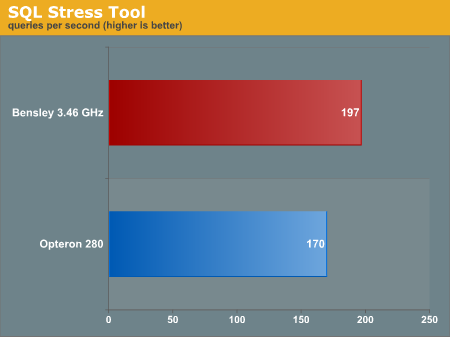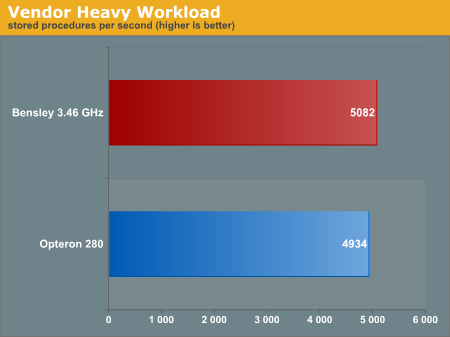Intel’s Dual-Core Xeon First Look
by Jason Clark & Ross Whitehead on December 16, 2005 12:05 AM EST- Posted in
- IT Computing
SQL Stress Tool Results(test description)
Intel’s pre-production Bensley system came out on top in this test, with a 14% lead over the Opteron 280 system. The 1066MHz front-side bus, no doubt, was required to achieve this result, along with the 2MB of L2 cache. Intel has always been competitive with AMD in this test, but was able to pick up an additional 4% this time around over their usual 10% lead.
This enterprise test has been of great interest to a lot of people, including Intel. Opteron has constantly dominated this test, but times have changed. Bensley essentially tied with the Opteron 280 in this test, as the difference was about 3% (which is standard deviation). The new Blackford chipset architecture, increased front-side bus and memory bandwidth all played a part in Bensley showing this kind of improvement. Where Opteron used to show, on average, a 15% gain over Intel, they are now neck and neck.
Intel’s pre-production Bensley system came out on top in this test, with a 14% lead over the Opteron 280 system. The 1066MHz front-side bus, no doubt, was required to achieve this result, along with the 2MB of L2 cache. Intel has always been competitive with AMD in this test, but was able to pick up an additional 4% this time around over their usual 10% lead.

This enterprise test has been of great interest to a lot of people, including Intel. Opteron has constantly dominated this test, but times have changed. Bensley essentially tied with the Opteron 280 in this test, as the difference was about 3% (which is standard deviation). The new Blackford chipset architecture, increased front-side bus and memory bandwidth all played a part in Bensley showing this kind of improvement. Where Opteron used to show, on average, a 15% gain over Intel, they are now neck and neck.











67 Comments
View All Comments
coldpower27 - Friday, December 16, 2005 - link
And I am interested how did you get a difference of $8140 to begin with.Furen - Friday, December 16, 2005 - link
I took a lot of shortcuts just to get a rough approximation but here it goes:406W - 260W = 166W
166W * 24H/day = 3984WH/day
3984WH/day * 365 days = 1,454,160WH/year = 1,454kWH/year
1,454kWH/year * $.14/kWH (which is overpriced, by the way, since consumers normally pay more than businesses) = $203.58/year
$203.58/year * 40 systems = $8143.30/year for 40 systems.
Viditor - Friday, December 16, 2005 - link
Good point...forgot about the power conversion and power supply loss.Furen - Friday, December 16, 2005 - link
I didn't mean PSU power loss, but rather that many data centers convert the AC input to DC at the distribution centers and the convert it to AC again just before sending it to the server, since servers are not built to operate on DC.PSU loss is already reflected in anadtech's measurements, since power consumption is measured at the plug.
Furen - Friday, December 16, 2005 - link
man, I would kill for an edit function on comments...Viditor - Friday, December 16, 2005 - link
You're forgetting the cost of cooling (which is much higher than just the CPU...)
coldpower27 - Friday, December 16, 2005 - link
They are measuring total power draw of the 2 systems which includes the energy used by the cooling system. I am not forgeting anything. I am only interested in cost of electricity used by the 2 systems.
Anandtech isn't incorporating cost of cooling into it's numbers either.
Jason Clark - Friday, December 16, 2005 - link
If we had complete systems from both vendors, this would have been possible. Unfortunately, we had a pre-production validation platform and a motherboard and two cpus from amd :)... So, what we did was make the bensley system as close to the open air opteron system as we could. I agree, we need to get some complete systems with their cooling mechanisms in place, and we'll work on the vendors next year for that.Viditor - Friday, December 16, 2005 - link
The cooling systems I refer to are the airconditioning, not the HSF or the case fans...By doubling the heat output, you are also doubling the air con requirements.
coldpower27 - Friday, December 16, 2005 - link
Which would be offset by the heating provided in the Winter time.